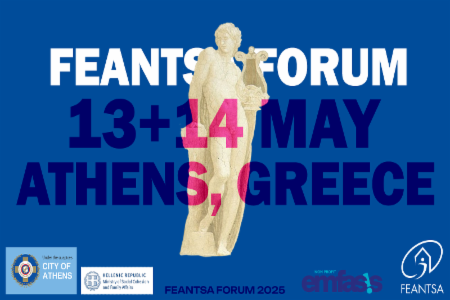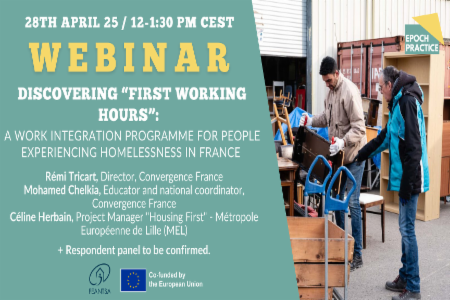The report "Social exclusion and COVID-19: the impact of the pandemic on the health, welfare and living conditions of homeless people", released by FACIAM, analyses the impact of the COVID-19 pandemic on the health, quality of life and living conditions of people experiencing homelessness and residential exclusion in Spain. Following this report, Guillermo Fernández Maíllo, General Director of Hijas de la Caridad Social Foundation, has written an article reflecting on Homelessness trends in post-pandemic Spain.
Homelessness trends in post-pandemic Spain
Guillermo Fernández Maíllo - Director General de Fundación Social Hijas de la Caridad (entidad miembro de la Red FACIAM)
Download the article in Spanish
Visit the webpage of the report
The most severe homelessness continues to grow in the post-pandemic period. Several factors act to create a cycle in which those who become homeless become trapped, undermining social mobility. In addition to the well-known gender gap, an age gap is beginning to emerge, with younger people becoming increasingly visible within the group. Adding to the difficulties of access to housing, the pandemic has jeopardised important elements for one’s survival, such as social networks and support from close family and friends, and has increased psychological stress.
On February 20, 2020, the first case of COVID-19 in Spain was officially reported. In these almost two years of the pandemic, the impact upon the general population has been monitored in different ways. However, there is hardly any information that allows us to understand its impact on homelessness and the people who are experiencing it. That is why FACIAM has developed a research process that tries to shed light on some aspects that affect one of the most invisible groups in Spanish society.[1]
The scope of the research is twofold. On the one hand, we have analysed the impact of the COVID-19 pandemic on the health, quality and living conditions of people experiencing homelessness and residential exclusion in Spain. On the other, we have examined the transformations generated by COVID-19 in the life trajectories that lead to homelessness.
For the analysis, we have considered the defining dimensions of social exclusion within homelessness, such as housing, access to income and social resources, health in its different dimensions, social support networks, etc. We have also looked at some less investigated aspects such as the digital gap, aporophobia and victimisation. Finally, we wanted to open our scope to aspects not so often considered, but which should be considered important, especially in the context as they can be linked to resilience, such as spirituality.[2]
Trends
The pandemic has increased the number of people experiencing homelessness. This increase is the result of two fundamental causes. On the one hand, it is caused by the interruption to processes of inclusion and social participation that people who had previously been living in a situation of homelessness and residential exclusion were already developing. Particularly problematic were the obstacles to accessing resources on which they usually relied. On the other hand, the general deterioration of the most excluded sectors of our society has decisively affected homeless people, increasing the volume of problems and difficulties they have to face for their survival.
Added to this increase is the lack of upward social mobility in the group. Only 1 in 4 people manage to move from ETHOS situations 1 and 2 (living rough or in emergency accommodation) to categories 3 and 4 (temporary or transitional accommodation). Not only is it very difficult to get out of homelessness and residential exclusion (only 10% of homeless people in Spain do so), but for many of those who manage to improve their situation, this improvement is only temporary. The public policies associated with the reduction of homelessness fail to eliminate its chronic nature.
The lack of access to permanent public housing in our country creates instability in the processes of reintegration and social inclusion. The next best thing for these processes, strong social networks, has been highlighted by the pandemic as key to survival. Although isolation and lack of support were common experiences for homeless people before the pandemic, they were intensified by it. A model for preventing and tackling homelessness based only on the right to housing is insufficient without the simultaneous development of the right to a community (family, close social network) that enables growth.
Homeless people are likely to be socially isolated and lacking community. During the pandemic, the public authorities insisted on social isolation as a protective factor. However, our data show that the rate of infection among homeless people is ten points higher than in the general population. The previous state of health (more than 30% report having a diagnosed physical or mental illness) but, above all, the living conditions during confinement have represented a fundamental risk factor for the infection and prevalence of the virus among this population.
The impact of the pandemic on health, especially mental health, has been severe among the general population. Pre-pandemic data from the Spanish National Health Survey estimated that 18% of the general population had a high level of psychological distress, indicating possible cases of mental health problems. Among people in a situation of homelessness and residential exclusion, there are no national pre-pandemic studies, but the data obtained in this research is truly worrying. A total of 67% of the participants report high levels of psychological distress, which, according to the standardised scales we have used, places a significant number of people at risk of presenting a possible psychiatric case. Specifically, being a woman and being young aggravates the possibility of poor mental health in the group of homeless people.
Added to this poorer quality of mental health among women is the increase in the gender gap as a result of aporophobia and victimisation to which they are subjected. Women’s feelings of discrimination are twice as high as men’s. This vulnerability increases even more if the woman is an immigrant. Gender-based violence, which is present in the most serious homelessness situations, is so complex that it often exceeds the capacity of specialised resources to deal with it. We must propose more integrated work approaches where all the dimensions of exclusion are considered.
On the other hand, another trend that has been detected is the increasing visibility of young people in the most severe homelessness, a situation that has been observed since before the pandemic. It seems that the pandemic has not intensified the presence of young people, but it has maintained the trend. One of the differentiating elements of homelessness among young people is the precariousness of their social relationships and social support networks. In fact, around 25% of young people report having no relationship with their parents. Furthermore, they are the group that has the worst access to financial benefits and that most frequently requests resources for accommodation and information, counselling and shelter. The finding of weaker relational frameworks is in line with other research that highlights the inelasticity of family relationships, causing a significant abandonment effect that cannot be compensated by housing-related alternatives alone. The existence affective networks and relationships with other people becomes key to the prevention of youth homelessness.
Finally, this research explores spirituality, an aspect of homelessness and residential exclusion that is rarely addressed. Between 50% and 60% of people in a situation of homelessness and residential exclusion in Spain report a need to rely on spirituality to deal with the difficulties they face in their lives. Spirituality is understood in most cases as linked to religion, but not necessarily. There are different ways of understanding it and connecting it with the different aspects that constitute it. In a broader sense, spirituality can be understood as the search for solace, strength and inner harmony. Specifically, women, people between the ages of 36 and 50, and people of African or Latin American origin are significantly more likely to identify as spiritual. The data obtained suggest the relevance of considering this dimension in the accompaniment processes for people in a situation of homelessness and residential exclusion in future. Assumed secularism may mean that the needs of many people are being ignored in social intervention processes.
[1] This article offers some of the more general conclusions of the Report “Social exclusion and COVID-19: the impact of the pandemic on the health, well-being and living conditions of homeless people”, the result of research carried out by FACIAM with the collaboration of the University Institute for Development and Cooperation of the Complutense University of Madrid. https://informecovidpsh.faciam.org/
[2] The research has used, on the one hand, a quantitative methodology through a survey on a convenience sample with quotas established according to four criteria: moment in which homelessness appears, operational definition of homelessness in two groups defined according to the ETHOS 1 categories and 2 (Homelessness) and ETHOS 3 and 4 (Residential exclusion), sex and origin. The sample consisted of 641 people. On the other hand, the research has been complemented with a qualitative biographical approach through 18 life stories with a sample of socio-structural, non-probabilistic and intentional representativeness.





